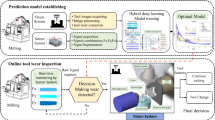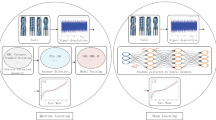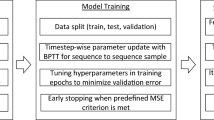Abstract
In metal cutting processing, prediction of the tool wear or VB value can help early warning and timely tool replacement before the tool reaches the service life. Although the deep neural network is an effective method to predict the tool wear, the existing research predicts the tool wear only at its next time moment without considering the tool states at different time points. It ignores important information of the tool wear. In this paper, we propose a comprehensive model, which consists of a monitoring module and a prediction module, to monitor and predict the tool wear for the first time. In the monitoring module, a DenseNet model is constructed to monitor the tool wear via sensor signals. In addition, the prediction module based on attention mechanism is developed by simulating the human brain attention to selectively focus on the important part of processing sequence information. An encoder-decoder structure is introduced for a multi-step prediction of the tool wear. Several VB values in the nearest future are predicted by using sequential VB values monitored in the latest past. Experimental studies show that the short-term information has more influence on the tool wear prediction than the long-term information. The proposed method has been used to predict multi-step VB values in milling operations.



















Similar content being viewed by others
Availability of data and materials
The datasets supporting the conclusions of this article are included within the article.
References
Torabi AJ, Er MJ, Li X, Lim BS, Peen GO (2015) Application of clustering methods for online tool condition monitoring and fault diagnosis in high-speed milling processes. IEEE Syst J 10(2):721–732. https://doi.org/10.1109/JSYST.2015.2425793
Lim CH, Kim MJ, Heo JY, Kim KJ (2018) Design of informatics-based services in manufacturing industries: case studies using large vehicle-related databases. J Intell Manuf 29(3):497–508. https://doi.org/10.1007/s10845-015-1123-8
Kumar A, Kaminski S, Melkote SN, Arcona C (2016) Effect of wear of diamond wire on surface morphology, roughness and subsurface damage of silicon wafers. Wear 364:163–168. https://doi.org/10.1016/j.wear.2016.07.009
Musfirah AH, Ghani JA, Haron CHC (2017) Tool wear and surface integrity of inconel 718 in dry and cryogenic coolant at high cutting speed. Wear 376:125–133. https://doi.org/10.1016/j.wear.2017.01.031
Aramesh M, Shaban Y, Yacout S, Attia MH, Kishawy HA, Balazinski M (2016) Survival life analysis applied to tool life estimation with variable cutting conditions when machining titanium metal matrix composites (Ti-MMCs). Mach Sci Technol 20(1):132–147. https://doi.org/10.1080/10910344.2015.1133916
Li ZJ, Peng XZ, Hu GB, Zhang D, Xu ZB, Peng Y, Xie SR (2022) Towards real-time self-powered sensing with ample redundant charges by a piezostack-based frequency-converted generator from human motions. Energy Convers Manage 258:115466. https://doi.org/10.1016/j.enconman.2022.115466
Azmi AI (2015) Monitoring of tool wear using measured machining forces and neuro-fuzzy modelling approaches during machining of GFRP composites. Adv Eng Softw 82:53–64. https://doi.org/10.1016/j.advengsoft.2014.12.010
Chen X, Zhang Z, Wang Q, Zhang DH, Luo M (2022) A new method for prediction of cutting force considering the influence of machine tool system and tool wear. Int J Adv Manuf Technol 120:1843–1852. https://doi.org/10.1007/s00170-022-08891-0
Nouni M, Fussell BK, Ziniti BL, Linder E (2015) Real-time tool wear monitoring in milling using a cutting condition independent method. Int J Mach Tool Manuf 89:1–13. https://doi.org/10.1016/j.ijmachtools.2014.10.011
Rmili W, Ouahabi A, Serra R, Leroy R (2016) An automatic system based on vibratory analysis for cutting tool wear monitoring. Measurement 77:117–123. https://doi.org/10.1016/j.measurement.202015.09.010
Huang W, Li Y, Wu X, Shen JY (2022) The wear detection of mill-grinding tool based on acoustic emission sensor. Int J Adv Manuf Technol. https://doi.org/10.1007/s00170-022-09058-7
Ren Q, Balazinski M, Baron L, Jemielniak K, Botez R, Achiche S (2014) Type-2 fuzzy tool condition monitoring system based on acoustic emission in micromilling. Inf Sci 255:121–134. https://doi.org/10.1016/j.ins.2013.06.010
He ZY, Shao HD, Ding ZY, Jiang HK, Cheng JS (2022) Modified deep auto-encoder driven by multi-source parameters for fault transfer prognosis of aero-engine. IEEE Trans Industr Electron 69(1):845–855. https://doi.org/10.1109/TIE.2021.3050382
Li HK, Wang YH, Zhao PS, Zhang XW, Zhou PL (2015) Cutting tool operational reliability prediction based on acoustic emission and logistic regression model. J Intell Manuf 26(5):923–931. https://doi.org/10.1007/s10845-014-0941-4
Ertunc HM, Loparo KA, Ocak H (2001) Tool wear condition monitoring in drilling operations using hidden Markov models (HMMs). Int J Mach Tools Manuf 41(9):1363–1384. https://doi.org/10.1016/S0890-6955(00)00112-7
Li WJ, Liu TS (2019) Time varying and condition adaptive hidden Markov model for tool wear state estimation and remaining useful life prediction in micro-milling. Mech Syst Signal Process 131:689–702. https://doi.org/10.1016/j.ymssp.2019.06.021
Kong DD, Chen Y, Li N, Duan CQ, Lu LX, Chen DX (2019) Relevance vector machine for tool wear prediction. Mech Syst Signal Process 127:573–594. https://doi.org/10.1016/j.ymssp.2019.03.023
Babu GS, Zhao PL, Li XL (2016) Deep convolutional neural network based regression approach for estimation of remaining useful life. In: International conference on database systems for advanced applications. Springer, pp 214–228 https://doi.org/10.1007/978-3-319-32025-0_14
Li X, Ding Q, Sun JQ (2018) Remaining useful life estimation in prognostics using deep convolution neural networks. Reliab Eng Syst Saf 172:1–11. https://doi.org/10.1016/j.ress.2017.11.021
Cao HR, Shao HD, Zhong X, Deng QW, Yang XK, Xuan JP (2022) Unsupervised domain-share CNN for machine fault transfer diagnosis from steady speeds to time-varying speeds. J Manuf Syst 62:186–198. https://doi.org/10.1016/j.jmsy.2021.11.016
Yin Y, Wang SX, Zhou J (2022) Multisensor-based tool wear diagnosis using 1D-CNN and DGCCA. Appl Intell. https://doi.org/10.1007/s10489-022-03773-0
Ghosh N, Ravi YB, Patra A, Mukhopadhyay S, Paul S, Mohanty AR, Chattopadhyay AB (2007) Estimation of tool wear during CNC milling using neural network-based sensor fusion. Mech Syst Signal Process 21(1):466–479. https://doi.org/10.1016/j.ymssp.2005.10.010
Xu XW, Wang JW, Ming WW, Chen M, An QL (2021) In-process tap tool wear monitoring and prediction using a novel model based on deep learning. Int J Adv Manuf Technol 112:453–466. https://doi.org/10.1007/s00170-020-06354-y
Zhao R, Yan RQ, Chen ZH, Mao KZ, Wang P, Gao RX (2019) Deep learning and its applications to machine health monitoring. Mech Syst Signal Process 115:213–237. https://doi.org/10.1016/j.ymssp.2018.05.050
Wu YT, Yuan M, Dong SP, Lin L, Liu YQ (2018) Remaining useful life estimation of engineered systems using vanilla LSTM neural networks. Neurocomputing 275:167–179. https://doi.org/10.1016/j.neucom.2017.05.063
Hinchi AZ, Tkiouat M (2018) Rolling element bearing remaining useful life estimation based on a convolutional long-short-term memory network. Procedia Computer Science 127:123–132. https://doi.org/10.1016/j.procs.2018.01.106
Yan D, Ding XY, Pan SY, Huang HY (2021) Tool wear prediction based on edge data processing and deep learning model. In: J Phys Conf Ser. IOP Publishing, 012165
Wang JJ, Yan JX, Li C, Gao RX, Zhao R (2019) Deep heterogeneous GRU model for predictive analytics in smart manufacturing: application to tool wear prediction. Comput Ind 111:1–14. https://doi.org/10.1016/j.compind.2019.06.001
Vaswani A, Shazeer N, Parmar N, Uszkoreit J, Jones L, Gomez AN, Kaiser L, Polosukhin I (2017) Attention is all you need. In: Advances in neural information processing systems, pp 5998–6008
Bahdanau D, Cho K, Bengio Y (2014) Neural machine translation by jointly learning to align and translate. https://doi.org/10.48550/arXiv.1409.0473
Luong MT, Pham H, Manning CD (2015) Effective approaches to attention-based neural machine translation. https://doi.org/10.48550/arXiv.1508.04025
Yin WP, Schütze H, Xiang B, Zhou B (2016) Abcnn: Attention-based convolutional neural network for modeling sentence pairs. Transactions of the Association for Computational Linguistics 4:259–272. https://doi.org/10.1162/tacl_a_00244
Liang YX, Ke SY, Zhang JB, Yi XW, Zheng Y (2018) Geoman: multi-level attention networks for geo-sensory time series prediction. In: Proceedings of the Twenty-Seventh International Joint Conference on Artificial Intelligence. IJCAI, pp 3428–3434
Yu DF, Fu JL, Mei T, Rui Y (2017) Multi-level attention networks for visual question answering. In: Proceedings of the IEEE Conference on Computer Vision and Pattern Recognition. IEEE, pp 4187–4195. https://doi.org/10.1109/CVPR.2017.446
PHM Society (2010) PHM data challenge. https://www.phmsociety.org/competition/phm/10
Funding
This work was supported in part by the National Natural Science Foundation of China under grant 51605422, in part by the Natural Science Foundation of Hebei Province under grant E2017203156, in part by Beijing-Tianjin-Hebei Cooperation Project of Hebei Province Natural Science Foundation under grant E2017203372, in part by the Chinese National Key Research and Development Program under grant 2016YFC0802900, in part by S&T Program of Hebei under grant 20311001D, and in part by S&T Program of Hebei under grant 20310401D.
Author information
Authors and Affiliations
Corresponding author
Ethics declarations
Consent for publication
All authors consent to the publication of the manuscript in this journal.
Conflict of interest
The authors declare no competing interests.
Additional information
Publisher's Note
Springer Nature remains neutral with regard to jurisdictional claims in published maps and institutional affiliations.
Rights and permissions
Springer Nature or its licensor holds exclusive rights to this article under a publishing agreement with the author(s) or other rightsholder(s); author self-archiving of the accepted manuscript version of this article is solely governed by the terms of such publishing agreement and applicable law.
About this article
Cite this article
Guo, B., Zhang, Q., Peng, Q. et al. Tool health monitoring and prediction via attention-based encoder-decoder with a multi-step mechanism. Int J Adv Manuf Technol 122, 685–695 (2022). https://doi.org/10.1007/s00170-022-09894-7
Received:
Accepted:
Published:
Issue Date:
DOI: https://doi.org/10.1007/s00170-022-09894-7




